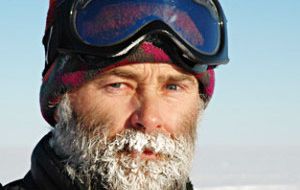MercoPress. South Atlantic News Agency
European scientists in Antarctica trying to locate the oldest ice on Earth
 Dr Robert Mulvaney from BAS is involved in the site survey at Little Dome C
Dr Robert Mulvaney from BAS is involved in the site survey at Little Dome C A team of European scientists heads to East Antarctica this month to locate the oldest ice on Earth. The team is part of an EU-funded research consortium from ten European countries whose aim is to search for a suitable site to drill an ice core to capture 1.5 million years of Earth’s climate history.
The project, Beyond EPICA – Oldest Ice (BE-OI), will answer important questions about big shifts in the past record of Earth’s climate. By extracting air from the tiny bubbles trapped in the ice, researchers will understand how the atmosphere’s composition has changed over time.
Dr Robert Mulvaney, ice core scientist from British Antarctic Survey (BAS), the UK partner in Beyond EPICA – Oldest Ice, and involved in the site survey explains: “In the early 2000s we drilled an ice core from Antarctica that gave us a climate record going back 800,000 years. Now we want to double the length of that record to investigate an important shift in Earth’s climate around one million years ago, when the planet’s climate cycle between cold glacial conditions and warmer interludes changed from being dominated by a 41,000-year pattern to a 100,000 year cycle.”
Understanding what controlled this shift in the Earth’s glacial cycles, and whether increasing carbon dioxide levels played a part, along with factors such as changes in the Earth’s rotational tilt, will help scientists to understand better how ice sheets will behave as the world warms.
Dr Mulvaney continues: “We need to understand the interaction between the Earth’s atmosphere and climate in very different conditions in the past if we are to be sure we can predict the future climate response to increasing greenhouse gases. There is no other place on Earth that retains such a long a record of the past atmosphere other than the Antarctic ice sheet, and it is tremendously exciting to be embarking now on the journey to recover this record.”
The team will survey several sites – at and near Little Dome C just 50 kms from the previous EPICA drill site located at the French-Italian research station Dome Concordia in East Antarctica – using radar towed behind a snow tractor, and drilling test boreholes, so they can determine the suitability of the site and the terrain at the bedrock beneath the ice.
The researchers, together with other BE-OI partners, will investigate the ice sheet’s thickness, its physical properties and the topography of the underlying bedrock at two different sites (Dome C and on the East Antarctic plateau at Dome F). Ice thickness is just a first indicator of past ice, as different snow accumulation, ice flow behaviour and the temperature at the bottom determine whether old ice remains near the base of the ice sheet.
“During previous studies we determined key regions where we expect the oldest continuous ice record on Earth” says Prof Olaf Eisen, project coordinator and glaciologist at the Alfred Wegener Institute (AWI). “Now we have to prove this and it is important that we learn as much as possible about deposition processes and the composition of the ice”, he explains.
Once a suitable drilling site is found, scientists will embark on a second phase multi-year project to extract an ice core from the surface to the bed at nearly 3km depth using traditional ice core drilling technology. Laboratories across Europe will analyse this ice to determine how the climate and the atmosphere have interacted over the past 1.5 million years.
Dome C (75.10’S, 123.35’E) is one of the most hostile environments on the planet, and average annual temperatures are below -54 degrees Celsius. The deep field party at Little Dome C, supported by those at Concordia Station, will travel hundreds of kilometres by tractor and skidoo over featureless snow where blizzards are common.





Top Comments
Disclaimer & comment rules
Read all commentsCommenting for this story is now closed.
If you have a Facebook account, become a fan and comment on our Facebook Page!